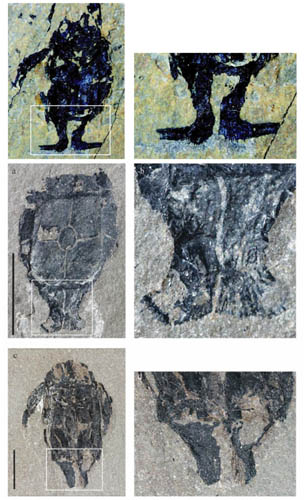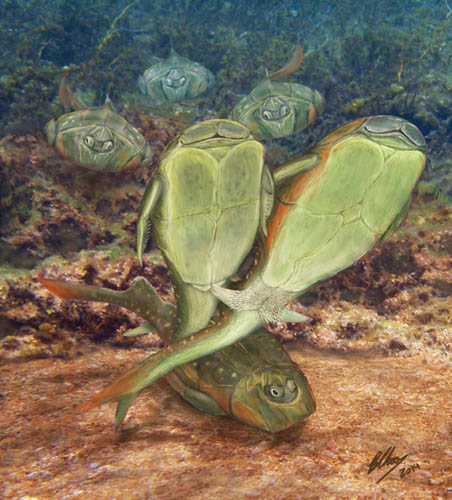Microbrachius dicki


A profound new discovery announced October 19 in Nature by an international team led by world-renowned palaeontologist, Flinders University Professor John Long, reveals how the intimate act of sexual intercourse first evolved in our deep distant ancestors.
In one of the biggest discoveries in the evolutionary history of sexual reproduction, scientists from Australia, China, Estonia, Sweden and the UK, who scrutinised a vast number of fossil specimens held in museum collections across the world, and found that internal fertilisation and copulation was invented by ancient armoured fishes, called placoderms, about 385 million years ago in Scotland.
Placoderms, the most primitive jawed vertebrates, are the earliest vertebrate ancestors of humans. The discovery shows that male fossils of the Microbrachius dicki , which belong to the antiarch group of placoderms, developed bony L-shaped genital limbs called claspers to transfer sperm to females; and females developed small paired bones to lock the male organs in place for mating.
Measuring about 8cm long, Microbrachius lived in ancient lake habitats in Scotland, as well as parts of Estonia and China.
As the paper’s lead author, Professor Long, who is the Strategic Professor in Palaeontology at Flinders University in South Australia, discovered the ancient fishes mating abilities when he stumbled across a single fossil bone in the collections of the University of Technology in Tallinn, Estonia, last year.
The fossils, he said, symbolise the most primitive known vertebrate sexual organ ever found, demonstrating the first use of internal fertilisation and copulation as a reproductive strategy known in the fossil record.
“Microbrachius means little arms but scientists have been baffled for centuries by what these bony paired arms were actually there for but we’ve solved this great mystery because they were there for mating, so that the male could position his claspers into the female genital area,” he said.
“It was previously thought that reproduction spawned externally in water, and much later down the track in the history of vertebrate evolution,” he said.
“Our earlier discoveries published in Nature in 2008 and 2009 of live birth and copulation in placoderms concerned more advanced placoderm groups. Our new discovery now pushes the origin of copulation back even further down the evolutionary ladder, to the most basal of all jawed animals.
“Basically it’s the first branch off the evolutionary tree where these reproductive strategies started.”
Dr Matt Friedman of the University of Oxford, who was not involved in the study said “The paper by Long and colleagues is nothing short of remarkable. Claspers in these fishes demand one of two alternative--but equally provocative--scenarios: either an unprecedented loss of internal fertilization in vertebrates, or the coherence of the armoured placoderms as a single branch in the tree of life. Both conclusions fly in the face of received wisdom, and suggest that there is still much to discover about this critical episode in our own extended evolutionary history.”
In one of the more bizarre findings of his research, Professor Long said the fishes probably copulated from a sideways position with their bony jointed arms locked together.
“This enabled the males to manoeuvre their genital organs into the right position for mating,” Professor Long said.
“With their arms interlocked, these fish looked more like they are square dancing the do-se-do rather than mating.”
Professor Long said the discovery also signifies the first time in evolutionary history that males and females showed distinct differences in their physical appearance.
“Until this point in evolution, the skeletons of jawed vertebrates couldn’t be distinguished because males and females had the same skeletal structures.
“This is the first time in vertebrate evolution that males and females developed separate reproductive structures, with males developing claspers, and females developing fixed plates to lock the claspers in for mating.”
The discovery highlights the importance of placoderms in the evolution of vertebrate animals, including humans.
“Placoderms were once thought to be a dead-end group with no live relatives but recent studies show that our own evolution is deeply rooted in placoderms, and that many of the features we have, such as jaws, teeth and paired limbs, first originated with this group of fishes,” Professor Long said,“Now, we reveal they gave us the intimate act of sexual intercourse as well.”
Download attachments: